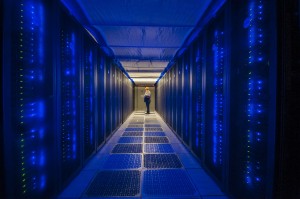Extreme weather: hi-tech predictions of impacts
More data and the use of modern computing technology are crucial to helping experts to assess the effects of severe weather on infrastructure and to find ways to mitigate impacts
Storms, heavy rainfall, drought or flooding can cause considerable humanitarian and economic loss. These extreme weather events can damage critical infrastructure, such as roads, railways or power and telecommunication grids.
During the latest flooding in the UK at the end of 2015, some 20,000 homes were left without power.
For society to be prepared, it is vital to know which infrastructure components are at risk or whether an entire network may break down during severe weather. The stakes are high, as extreme weather events are expected to become more frequent in the future due to climate change.
In a bid to reduce these uncertainties, scientists use complex computer simulations and large amounts of data. The advent of high performance computing along with much more data available now, coupled with increased scientific knowledge have greatly improved weather forecasting.
But this could be improved even more. Particularly when it comes to rainfall, “the impact of extreme weather is hard to forecast”, says Herman Russchenberg, director of the TU Delft Climate Institute, the Netherlands. This is because forecasts lack the details, which are necessary to assess risks on smaller scales, for example for certain infrastructure components or within cities.
In the future, high-tech instruments, such as the next generation of weather radars, will provide more detailed data, Russchenberg hopes. Moreover, citizen scientists voluntarily supplying data obtained with their mobile phones will add to the large data pool.
“Combining all these sources of information and feeding them into high-resolution models will allow us to produce better rain forecasts,” he says.
To actually assess the consequences of severe weather, more knowledge, such as on the condition of infrastructure, is also necessary.
But while infrastructure owners – public authorities or private companies – do keep valuable data sets, these are not well utilised yet, says Daniel Straub, professor for Engineering Risk Analysis at the Technical University of Munich, Germany. Besides, “you need more complex models to extrapolate this data and to assess how certain infrastructure reacts under extreme weather conditions,” he adds.
This is precisely what researchers within the RAIN project want to achieve. “We collect data across Europe. We learn from that data and train our models to simulate what happens when the weather is intensified,” says Pieter van Gelder, professor of Safety Science, and director of the Safety and Security Institute at the Delft University of Technology.
Satellite images are becoming better and drone technology will provide more detailed information on infrastructure networks. This will result in terabytes of data, which can only be handled by using advanced supercomputers, van Gelder stresses.
“That’s really going to be a big data issue,” Russchenberg agrees. Indeed, the future computer architecture for handling the tasks will be a hybrid system, he holds.
Weather services will provide larger forecasts using high performance computing. But to zoom in on sensitive areas and infrastructure, models will be run on distributive systems, he concludes.
Constanze Böttcher
Photo credits: Sandia Labs
10 March 2016
